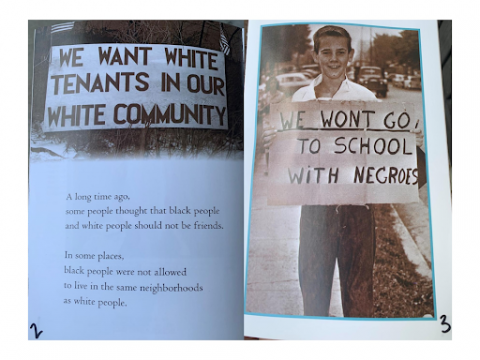By Alice Levine
Many teachers share books and videos with their students about Civil Rights, especially near MLK’s birthday in January and during Black History Month in February or as part of units of study in ELA or Social Studies.
Since I grew up during a school desegregation struggle in New Jersey during the 1960’s, I began to wonder whether students are still learning about Jim Crow and Civil Rights as exclusively Southern phenomena. I began to look at every fiction and non-fiction book I could find about the Civil Rights era, and found that the history in the North had largely been erased.
I did quite a comprehensive search of picture books and found fewer than 10 (depending on how I defined the time period), and so far I have not identified many more for middle grade or YA students. Because there were so few books available, I spent many months searching for photos, newspaper articles and other material that would help me understand the real history of Jim Crow North and resistance to it.
To ensure that teachers and students develop a broader and more accurate picture of Jim Crow as a nationwide problem and Civil Rights as a coast-to-coast movement, it is important that we are intentional about finding books and other resources that tell stories from outside the South.
I am still in the midst of learning this history myself, but based on my findings, I think that erasure of stories of Civil Rights in the North have occurred because:
- In many cases, there was never written evidence (e.g. signs for Sundown Towns or for segregated swimming pools in the North) but everyone “knew” that Black people were not allowed.
- The evidence that did exist has been (perhaps purposely?) lost.
- Many of us have become so convinced that Civil Rights is a Southern story that we don’t notice when all the books we are sharing with our students take place in Southern states. Most teachers, students, librarians, and administrators do not notice the absence of stories from the North and West.
- As Adam Sanchez of Zinn Education Project says, the master narrative of the Civil Rights Movement “reinforces the myth of progress, one in which most Americans, especially those in the North, responded positively to the demands of the Civil Rights Movement and righted the wrongs of lingering Southern racism.”
- Sometimes photos or other evidence are used in ways where readers are likely to assume that they come from the South, when in fact they did not! Here’s one example:
The photo on the left was included in this early reader written by Ruby Bridges about her experiences in New Orleans. Where would you think that photo was taken? When I read the book with a student, I assumed that the photo was from New Orleans or a nearby Southern town. When I accidentally came upon this photo months later, I was shocked to learn that it was actually from Detroit, Michigan!
https://www.loc.gov/pictures/item/2017844754/
Some of the questions that came up in my research, which I look forward to discussing with other educators are:
- Is there really as sharp a distinction between de facto and de jure segregation as I was taught?
- Is there really such a clear distinction between North and South as I imagined? How important is the Mason Dixon line as a demarcation?
- What is the significance of this history being erased? Was the erasure deliberate? Who benefits from the omission and suppression of the Northern stories of Jim Crow?





